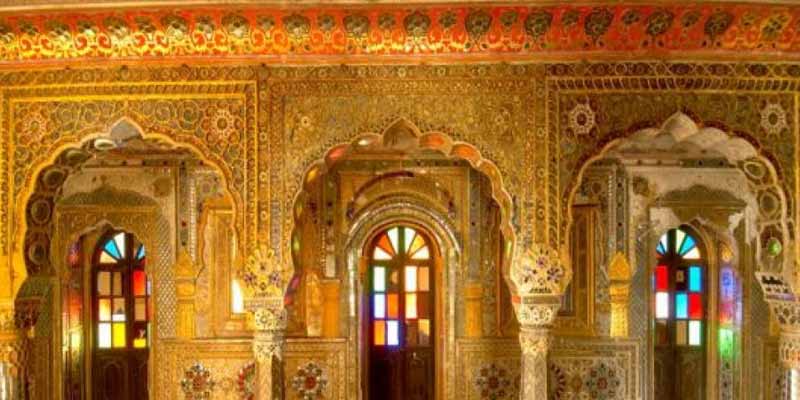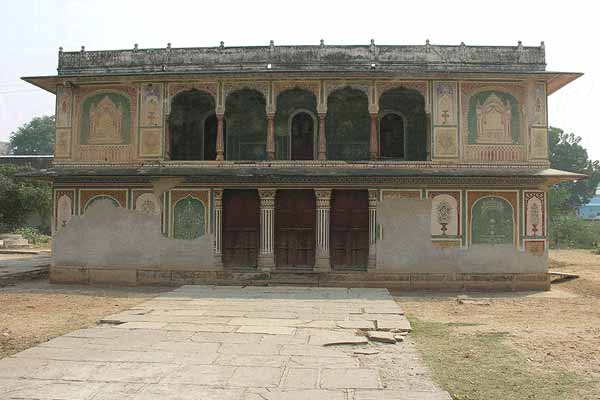Sunehri Kothi Tonk, located in Tonk, Rajasthan, is a historical gem that reflects the grandeur of the region’s architecture and cultural heritage. “Sunehri Kothi” translates to “Golden Mansion,” and this exquisite structure lives up to its name.
Built during the rule of Nawab Mohammed Ibrahim Ali Khan in the early 20th century, Sunehri Kothi showcases a blend of Rajput and Mughal architectural styles. The golden hue of the mansion, adorned with intricate carvings and detailed embellishments, mesmerizes visitors. Its opulent design and spacious courtyards reflect the luxurious lifestyle of the nobility during that era.
Sunehri Kothi has witnessed the passage of time, preserving tales of royal gatherings and cultural celebrations within its walls. Today, it stands as a testament to Tonk‘s rich history and architectural prowess. Visitors can explore its rooms, corridors, and gardens, immersing themselves in the bygone era. The Kothi serves as a living museum, offering a glimpse into Rajasthan’s regal past and the artistic finesse that defined its architectural marvels Rajasthan Monuments.

History of Sunehri Kothi Tonk
Sunehri Kothi, also known as the Mansion of Gold, is a historic building located in the city of Tonk, Rajasthan, India. Built in the early 20th century, it stands as a testament to the architectural grandeur and cultural heritage of the region.
The construction of Sunehri Kothi was commissioned by Nawab Mohammed Ibrahim Ali Khan, who ruled Tonk from 1867 to 1930. Nawab Ibrahim Ali Khan was known for his patronage of art, culture, and architecture, and Sunehri Kothi was one of his ambitious projects aimed at showcasing the opulence and splendor of his reign.
The Kothi was designed by British architect Sir Swinton Jacob, who was renowned for his Indo-Saracenic architectural style. The building is characterized by its impressive façade adorned with intricate carvings, detailed embellishments, and a distinctive golden hue, which earned it the name “Sunehri Kothi.”
Throughout its history, Sunehri Kothi has served various purposes, including as a royal residence, administrative center, and cultural hub. It has witnessed significant events and hosted numerous dignitaries and guests, contributing to the rich tapestry of Tonk’s history.
Today, Sunehri Kothi stands as a symbol of Tonk’s heritage and continues to attract visitors from around the world who marvel at its architectural beauty and historical significance. It remains a cherished landmark, preserving the legacy of Nawab Ibrahim Ali Khan and the cultural richness of Rajasthan.
Places to Visit Near Sunehri Kothi
There are several fascinating places to visit near Sunehri Kothi in Tonk, Rajasthan, each offering a unique glimpse into the region’s history and culture:
Tonk Fort: Located in close proximity to Sunehri Kothi, Tonk Fort is an ancient structure that dates back to the 17th century. It stands as a symbol of the region’s military and architectural heritage, offering panoramic views of the surrounding landscape.
Bisalpur Dam: Situated about 45 kilometers from Tonk, Bisalpur Dam is a serene spot amidst picturesque surroundings. Visitors can enjoy boating, picnics, and bird watching at this scenic reservoir, which also serves as a significant water source for the region.
Bisalpur Mandir: Near the Bisalpur Dam, Bisalpur Mandir is a revered Hindu temple dedicated to Lord Rama. The temple’s architecture and spiritual ambiance attract devotees and tourists alike.
Hathi Bhata: Translating to “Elephant Rocks,” Hathi Bhata is a geological marvel located around 20 kilometers from Tonk. This site features massive rock formations resembling elephants, making it a unique and intriguing destination for nature enthusiasts.
Raj Mahal: Situated in the heart of Tonk city, Raj Mahal is a historic palace known for its exquisite architecture and royal charm. Visitors can explore its ornate interiors, including intricately designed halls, courtyards, and gardens.
Gopal Sagar Lake: Located about 7 kilometers from Tonk, Gopal Sagar Lake is a serene oasis surrounded by lush greenery. It offers opportunities for leisurely walks, bird watching, and enjoying the tranquil ambiance.
These are just a few of the many attractions near Sunehri Kothi Tonk, providing visitors with a diverse range of experiences that showcase the rich cultural and natural heritage of the region.
How to Reach Sunehri Kothi Tonk
Reaching Sunehri Kothi in Tonk, Rajasthan, is relatively straightforward due to its central location within the city. Here are several common modes of transportation you can use to reach Sunehri Kothi:
By Road: Tonk is well-connected by road to major cities in Rajasthan and neighboring states. You can reach Tonk via state-run buses, private buses, or hired taxis/cabs from nearby cities like Jaipur, Ajmer, and Kota. Once you arrive in Tonk, Sunehri Kothi is typically within walking distance or a short auto-rickshaw ride from the bus stand or taxi stand.
By Train: Tonk has its railway station, which is connected to major cities like Jaipur, Kota, and Delhi. From the Tonk Railway Station, Sunehri Kothi is easily accessible by auto-rickshaw or taxi, which are readily available outside the station.
By Air: The nearest airport to Tonk is the Jaipur International Airport, located approximately 100 kilometers away. From Jaipur, you can hire a taxi or take a bus to reach Tonk. Once in Tonk, you can use local transportation like auto-rickshaws to reach Sunehri Kothi.
By Private Vehicle: If you’re traveling by your own vehicle or a rented car, Tonk is accessible via well-maintained roads. The city is located on National Highway 52, making it easily reachable from nearby cities. Sunehri Kothi is located in the heart of Tonk, so you can follow directions to the city center and then navigate to the Kothi.
Once you reach Tonk, navigating to Sunehri Kothi Tonk is relatively simple, as it is a well-known landmark in the city. Local residents and transportation providers can guide you to the Kothi if needed Tourist Places Rajasthan.
